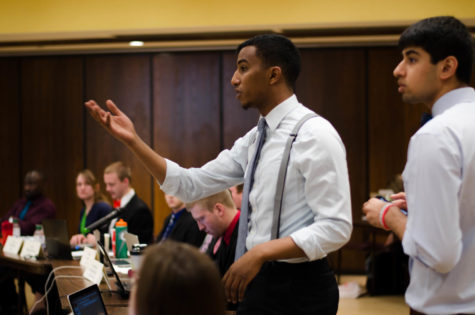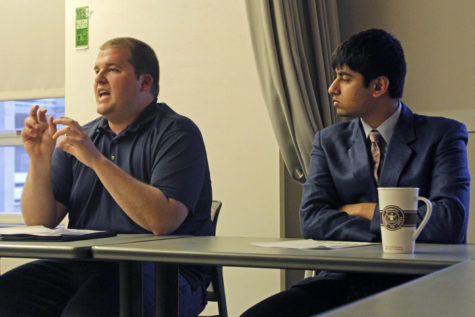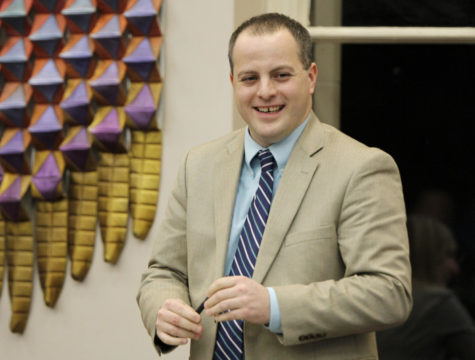Student governments come together
July 7, 1998
It is an annual event that receives almost as much hype as Veishea or Homecoming. Although students at Iowa’s three regents universities may not be as excited about the yearly tuition increase as they are about those celebrations, it receives just as much attention.
“We spent about three weeks crunching numbers, preparing data and writing speeches about tuition,” said Jeremy Williams, Iowa State’s GSB finance director.
Tuition is one of the major issues student governments in the state deal with each year. Student leaders at University of Iowa, University of Northern Iowa and ISU face a wide variety of topics on any given day.
“There is never a typical day,” said Bryan Burkhardt, GSB president at ISU.
Student government representatives at the three regents universities may never have an ordinary day, but they do share common issues as Iowa universities. All three organizations allocate student fees to student groups and work with their administrations on a variety of issues.
Despite some common problems, executives at the schools say they have worked little with the other universities.
“We’re so very different that it’s hard to work together,” said Rob Wiese, 1997-98 GSB president at ISU.
ISU’s GSB opposed the proposed 3.9 percent tuition increase in the fall of 1997 and presented their view to the Board of Regents. Wiese said ISU discussed their presentations with the other regents universities before approaching the board.
“We worked together a little on tuition,” Wiese said. “We agreed with UNI on what to lobby for [regarding tuition].”
Student government leaders agree that tuition research is the one area on which the regent universities could cooperate. Sarah Pettinger, executive official of the University of Iowa’s activity senate, said the three schools could work to present a united opinion on tuition to the Board of Regents.
“If we work with ISU and UNI as far as tuition goes, we can hold the regents accountable and make sure they put money where the students want it spent,” Pettinger said.
The University of Iowa did an extensive tuition survey in 1997, and Pettinger said school officials hope to work with ISU in 1998 to present a similar survey to the regents.
Scott Meskiman, Northern Iowa Student Government’s vice-president, agreed that the three universities could present a stronger argument against tuition increases by working together.
“It’s going to look better whenever we go to the regents as a unified group,” he said.
Burkhardt said he hoped to use UNI and Iowa’s governments as resources for projects on ISU’s campus.
“I’d like to talk to the other two about how they handle lighting and emergency phones,” Burkhardt said.
Although Burkhardt said he believed the universities could share information, he thought different campus climates might create a barrier.
“[The other universities] don’t know our students,” he said.
The three regents universities currently have no formal interaction on a regular basis. Terri Houston, former assistant dean of students at ISU and adviser to GSB, said the three executive branches used to meet monthly.
The organization, called the United Students of Iowa, brought together two representatives from each of the three universities to discuss common issues they were facing.
Williams said each school had a campus director and assistant director, as well as two board members. USI lobbied to both the Board of Regents and the Iowa legislature regarding issues including increased financial aid for the regents institutions and tuition.
“It was a group that could legitimately represent all three schools,” Williams said.
Houston said the group provided an opportunity for student governments to be clear on their positions before issues occurred.
“If we’re continually communicating, we have a stronger voice to lobby against whatever may be happening,” she said.
United Students of Iowa disbanded in 1995 due to cuts in funding by Iowa and ISU, Williams said.
Whether they approach the Board of Regents individually or united with other student governments, student leaders often question whether their concerns are truly addressed.
“The regents listen to student government presidents and the regents respond when they know it’s a matter of great concern to students,” Houston said.
Lisa Ahrens, student member of Iowa’s Board of Regents, said the board considers student input. Ahrens, sophomore in agronomy at ISU, received criticism when she voted in favor of the 3.9 percent tuition increase last fall.
“I always hear, ‘the regents don’t care,’ but they do,” she said. “Every regent reads every piece of mail they get. They are very student-oriented people.”
Burkhardt said student government should be able to approach the board with topics concerning students.
“We should feel comfortable addressing the regents and showing the student perspective,” he said.
Houston said although the regents are receptive to student-oriented issues, tuition opposition appears to have little effect on the board.
“I think they hear [the opposition to tuition increases], but I don’t think they really listen,” she said.
Student government representatives said they have had more success dealing with their administrations than the regents.
Scott Shuman, vice-president of the University of Iowa Student Government, said he and president Brian White worked with administration during their time as senators, but that interaction has increased since they took their executive offices.
The UISG president and vice-president have weekly meetings with the vice president of the university and dean of students. Shuman said the frequent meetings have led to an efficient working relationship between student government and the university administration.
“They’re very interested in the issues,” Shuman said. “The administration is usually very receptive to the ideas we have and usually willing to work with us on major projects.”
Shuman said he and White also meet one to two times per month with University of Iowa President Mary Sue Coleman.
ISU’s GSB has also worked with administration on several projects, including the renovation of Lake Laverne.
Wiese said he had disagreements about the tuition increase with ISU President Martin Jischke during his 1997-98 term as president. Wiese said the clash of perspectives did not affect their ability to work together.
“With being the student body representative, you have some conflicts of viewpoint on some things,” Wiese said. “If [Jischke] has a student government that doesn’t let him know what’s going on, you’re going to have a bad year all around.”
Jischke said he did not view Wiese’s opposition to the tuition increase, which Jischke supported, as a conflict but merely a difference of opinion.
“I respect the office [of GSB president] as one that represents the students of ISU, and there are circumstances where my judgment as to what’s best for the university may not be the same as the president’s view of what’s best for the students,” Jischke said.
Despite each of their distinct circumstances, the student executives of Iowa’s three universities said they hoped to work with their colleagues around the state more in the upcoming year.
“It’s important that we do see how they’re working,” Meskiman said. “Hopefully we can do that and keep up the communication.”
Shuman also said the three universities could benefit from shared research and project coordination.
“Because of the way our state is set up, it would probably be to our advantage to work more closely to create projects within the state,” he said.
“We’re looking forward to working with student government both at ISU and UNI and hope that we can make a huge push on the Board of Regents next year,” Shuman said.









